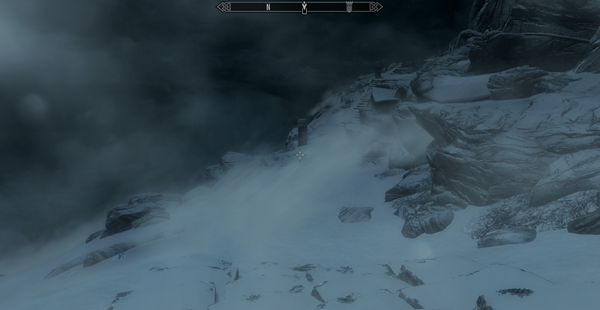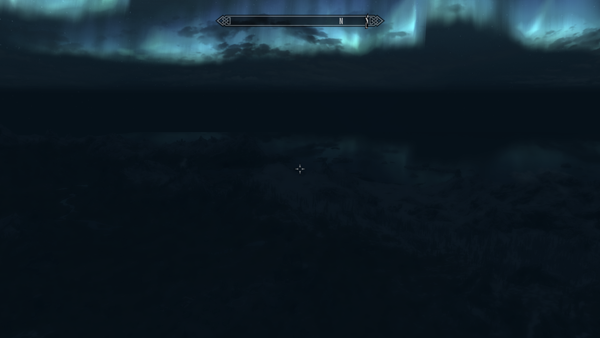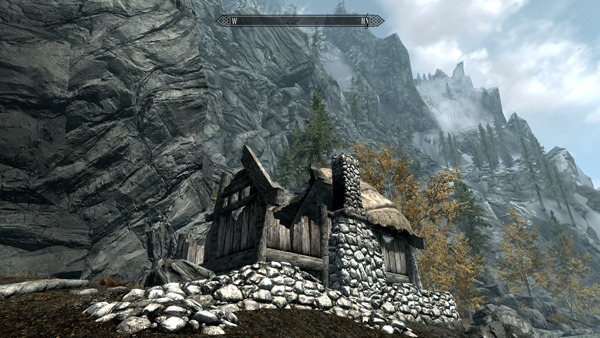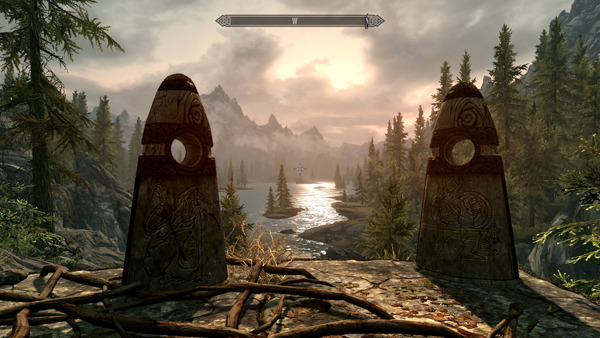
The Worlds of Skyrim
Bartłomiej Musajew on how he learned to contain multitudes.
For the man who delivers food to the monastery, the stairs are a metaphor for the passing of days signifying on a muscular level; their sight and the anticipation of the next climb mixed with the memories of previous ones evoke the increasing strain and exhaustion, the gradual wearing out of his aging body. For the pilgrim, the stairs are a promise of ascension, the numbing of the flesh by the cold leaving the spirit free to merge with the world at an altitude where things themselves lose their outlines. For the women in the village, the stairs are a dream of adventure, a way their imagination can escape the tedium and toil of their daily existence. For the man unmoored from the present, his perception of reality blotted out by the image of his lost sister, there are no stairs.
The stairs in question are the Seven Thousand Steps leading from the mountainside village of Ivarstead to the monastery of High Hrothgar. A player approaching them for the first time will overhear two men talking about a delivery of supplies, one of them revealing that he is not ready for the climb and that he has never been admitted inside the monastery. The player can chat with him to learn more about his attitude and experiences. Each of the things he has to say adds a shade of meaning to the climb. When asked whether he receives anything in return for his trouble, he answers in the negative, because he and the monks have “a kind of understanding between them,” and “it just wouldn’t feel right to charge them for a bit of preserved food.” Then he adds, however, that his “legs aren’t what they used to be and climbing the 7,000 Steps takes its toll.” The unexpressed resentment that his effort goes unrewarded, and that he is considered beneath the order’s attention, surfaces as a somatic symptom: exhaustion at the mere thought of climbing the stairs. Furthermore, the stairs evoke for him the process of aging through comparison with his past climbs. This bodily reaction is emphasized by the warning that “in these wintry conditions, the stairs can be treacherous,” which endows them with vicarious materiality — although the player’s avatar can scale the digital blocks without the slightest difficulty, their mass and texture, their slipperiness and stony hardness, their existence as unforgiving forces of nature in conflict with the human body, have all been attested to. Thus, from a short talk with this minor character we can glean a lot about one possible experience of a space, and also about how this experience is determined by class relations and power structures. Perhaps even a big-budget fantasy RPG with trolls and dragons in it can teach us something about the intricacies of being human. But if we want this to happen, we need to listen closely to what Skyrim inhabitants have to say.

The steps will have a different meaning for a pilgrim, who occasionally affords themselves the trek for religious purposes (despised by the inhabitants of Ivarstead as passersby). In turn, the pilgrim’s experience has nothing to do with that of the women in the village, whose sighs of boredom, craving for tales of adventure, and dreams of setting off with the player betray the tedium of their situation. However, their attitude towards the monastery is ambivalent, as testified by Boti who, using an image engaging the senses, swears she “can hear strange noises rolling down from up there.” The monastery’s inaccessibility fuels speculation and endows it with a phantasmal dimension for the villagers. Finally, Narfi, a distraught man, babbling in an infantile manner about his missing sister (“I can’t see you, Reyda! I can’t find you! Why are you hiding? Hiding, hide, hide, hide! Don’t make me sad!”), is apparently so cut off from the reality of things that for him the entire village is just a blurry background to the vivid memory of his sibling. His mental isolation is emphasized by his destroyed house situated close to a cold mountain wall, and by the way other inhabitants dismiss him with the condescending adjective “harmless.”
Virtual worlds, just like our own, can have as many meanings as there are people inhabiting them, and Skyrim is one such world, where objects and places acquire different narrative, affective, imaginary, and ideological dimensions, depending on the point of view the player chooses or is made to identify with. These points of view are made explicit in this textually rich game as various characters, communities, institutions, and writers try to include the player in their individual or collective experience by pointing, showing the way, naming, describing, reminiscing, and narrating. A town will be experienced differently by its ruler surveying it from his balcony; by the author of a report for Imperial officers, who perceives it as something to be subjugated; by a company of local warriors, for whom the city is endowed with historical and mythical dimensions linked with their past; by two ancient families vying for influence; or by a libertine guide writer looking for pleasure. This process of assuming different perspectives is facilitated by the fact that the avatar is an outsider, a figure that combines the contrasting roles of a tomb-crawling pariah, associated with the world of the dead and with corruptible matter, and of a partly divine hero, without any fixed identity and a stable place in the mundane realm of human societies.

The game starts in a cart carrying prisoners for a beheading in Helgen, not yet in ruins. One of them, Ralof of Riverwood, in a nostalgic mood prompted by the approaching execution, says that “a Nord’s last thoughts should be of home.” After entering the town, he mentions a girl he’d known there, whom he used to be “sweet on.” This gustatory metaphor leads to a memory of “that mead with juniper berries mixed in” made here. This in turn makes him remember the sense of safety provided by the Imperial walls and towers when he was a boy (ironic in this context, as Imperial soldiers are about to kill him). These reminiscences are interrupted by the arrival at the place of execution.
After an escape, made possible by the appearance of a dragon and the player’s guide’s intimate knowledge of the town, the player ends up on a path leading to the village of Riverwood, accompanied (depending on a previous choice) by either Ralof or Hadvar, an Imperial soldier also born there. On reaching a spot facing Bleak Falls Barrow, an ancient structure poking out of the mountain opposite like the ribs of a giant skeleton, the player’s guide points at it to express his feelings. I’ll quote Hadvar’s words, as they convey a vivid image: “When I was a boy, that place always used to give me nightmares. Draugr creeping down the mountain to climb through my window at night, that kind of thing. I admit, I still don’t much like the look of it.” Significantly, this is not the only time the Barrow is pointed at. Once in Riverwood, the player can accept a quest from a local store owner to retrieve a precious ornament from the tomb. He sends his sister along with the player to show the way (but forbids her to go further than the edge of the village, so she can only point in the general direction). Later on, after receiving the object, he says that it seems smaller than he remembers: “Funny thing, huh?”

The player can experience the same path from yet another perspective by following Marcius Carvain’s An Explorer’s Guide to Skyrim. The guide is focused on the Stones of Fate, some located along this path. The author dismisses the belief in the magical properties of the stones as folk superstition, emphasizing the class distinction he wants to establish (the book is aimed at “noble visitors from Cyrodiil,” considered superior because of their noble descent from the seat of the empire). As for Helgen, he calls it a “backwater hovel,” a place to be passed by on the way to view Lake Ilinalta. Carvain considers the view “sublime,” especially when seen at sunset from a small bluff at the eastern end of the lake, the location of the stones. As an aside, it is worth mentioning that the belief in the stones’ power is not limited to the uneducated. For Gelyph Sig, Thane of Bjorin, and the author of the Watcher of Stones, the stones become an obsession directing the course of his life, which leads to disappointment as they never respond to his actions. Finally, in his old age he identifies with the stones, passive and forlorn, ignored by all: “I am an old man, with no fight left in me. And so here I sit, watching the faces of those who pass by on their daily errands, their mundane travels from one city or town to another. Most of you do not even give the stones a passing glance. You have never heard their call, you will never feel drawn to them. Some days, I envy you that.”
I’ve just described completely different experiences of one place. The villagers’ reminiscences and dreams are determined by the localities they grew up in and the objects surrounding them. The acts of pointing and guiding prove that particular locations are not just points on the map, but that they are related to one another in an organic way. This way of relating has been developed over the years, for instance during regular trips from the village to the town. The way the size of the ornament is exaggerated in the store keeper’s memory only emphasizes that for the inhabitants the space around them is endowed with an additional dimension imperceptible to an outsider.
The author of the guide is more interested in the landscape than its context, Helgen and Riverwood not worthy of his consideration. That’s why he needs solid and clearly visible landmarks, in this case the stones, to anchor his experience. However, this is not just a case of the superficial tourist gaze, because the guide endows the landscape, which for the player would probably become just another blur between one quest marker and another, with depth by focusing attention through description, and by situating various physical features in relation to one another (albeit in a strictly geographic sense untainted by emotions). The only feeling the writer allows himself is a strongly affected one: a sensation referred to as “sublime,” hinting at his aristocratic skill of aesthetic appreciation. Finally, Gelyph’s sense of space is limited to significant points, everything else around him a vague contrast to the immutable and unyielding substantiality of the stones.The concerns of other people are dismissed by him as mundane, the world is reduced to interchangeable towns and cities, and when he looks at others’ faces, it is only in relation to the stones.

So far, I’ve been concerned mainly by what the characters say and write. We shouldn’t forget, however, that speech and writing are not just disembodied media, but themselves are also rooted in physical circumstances. Speech is always uttered at a particular spot, which partially determines the meaning of words. For instance, the already mentioned act of pointing, the gestural counterpart of the word “there,” establishes a spatial relation between the person pointing and the place being pointed at, entangling the objective meaning of words with the experience of the speaker. While writing is not subject to the same process, books are still objects that have to be published and distributed, circulating along determined routes and functioning in specific contexts. Various references and debates going on in the omnipresent in-game books imply a vigorous academic exchange and the existence of a lucrative publishing market.
This also means that these texts do not purvey purely objective information, but only versions and partially established truths, often determined by the different parties’ perception of the world. For instance, in order to get admitted to the Bards College in the city of Solitude, the player needs to find a lost manuscript containing verse that defames the legendary King Olaf—the captor of a dragon that wreaked havoc in Skyrim centuries before the time of the game—thus justifying the annual burning of his effigy. However, the manuscript is partially illegible, so the player needs to make up several lines for the performance before the jarl of Solitude, aimed at obtaining her permission to continue the festival. The legitimacy of the physical object, partially destroyed, and the performance by a professional bard are used to mask false additions to a text that itself may or may not contain a true account of the events. The player can surmise that the inhabitants of another city, Whiterun, would prefer Olaf’s reputation to remain untarnished. After all, this is where Dragonsreach, a place where he allegedly imprisoned the dragon (as the player can learn from Adonato Leotelli’s Olaf and the Dragon, containing various versions of the legend and also a mention of the lost manuscript), is located, probably generating considerable income from tourism. This example shows the complexity of the interaction between a text, its physical form, its circulation, the context of its reception, and its relation to truth. If we ignore the fantastic nature of the legend, these disputes over the use and meaning of public, albeit virtual, space may seem familiar, given today’s concern with historical justice, and with the ideological implications of history writing and monument creation and preservation.
Sometimes even the precise location of a book relative to other objects can tell us a lot about the experience of its reader. In the Understone Keep at Markarth the player meets Calcelmo, a disgruntled scholar working at an excavation of ancient Dwemer ruins. From the books he authored, the player learns that the Dwemer were an extremely rational race, favoring durable materials, like stone, and well-calculated architectural designs based on angular forms as opposed to curves and arcs. As can be easily guessed, their constructions are a tomb-like space, a mixture of geometry, stone, and death that offers no solace to the visitor. In this way, they are also a perfect embodiment of Calcelmo’s state of mind, as his first reaction is to lash out at the player for disrupting his work.

Nearby, the player can find a book on another culture, the Dunmer, lit by soft candlelight, and accompanied by a bottle of wine. The book is an account of a cult of ancestors who live on in a pleasant otherworld, contrasted with “our real world, which is cold, bitter, and full of pain and loss,” and sometimes haunted by mad spirits. We can easily imagine an assistant depressed by the atmosphere of the place, yearning for comfort, trying to find some warmth in the contents of the bottle, and identifying with the ghost roaming the cold realm of the living. This is one of the many experiences in this game that, slightly misusing Walt Whitman’s expression, contains multitudes, whose contradictory, multifaceted experiences it tries to impart to the player. And while, in order for this process to work, the player needs to be receptive and put in some additional imaginative effort, the rewards are worth it. Not only will the world of the game acquire depth and complexity (and linger in memory much longer and with more clarity than it would if it were reduced to an indistinct mass of dungeons and landscapes), but also, perhaps, the player will broaden their perception to encompass the many individual ways of experiencing, each creating a miniature world, contained in our own reality. After all, even a long climb of several thousand stairs can be much more than just the stone of its steps.
Bartłomiej Musajew is a PhD student interested in literature and videogames. He lives in Warsaw, Poland.